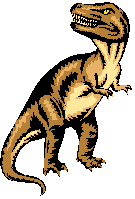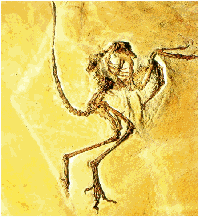In This Issue
|
Dave and Laurie Trexler have spent two seasons digging a large Tyrannosaurid in Two Medicine Formation of the later Cretaceous. It is apparently a Daspletosaurus, but Trexler is unwilling to say for sure until he has all of the animal prepared, and all of the information that will allow him to identify the giant. Some digging remains to complete the removal. Much of the skull was recovered, including diagnostic parts, according to Trexler. The prepation work began this past winter. Laurie Trexler, of Timescale Adventures, will lead this effort. The Wyoming Dinosaur Center will display Daspletosaurus in the year 2,000. |
|
|
Theropods: The meat-eating dinosaurs were called the Theropods which means "beast foot". They first appeared in the Triassic about 230 million years ago, living for 160 million years. They are found at most dinosaur localities but they tend to be rare . During the Jurassic there was a diverse group of theropods especially during the time when the Morrison Formation was deposited. There were Ceratosauroids, a primitive, medium to large, meat eating dinosaur. There was the small Compsognathus and Ornitholestes. And giants like the Megalosauroids and the allosaurs. Theropods were slender, long-legged, bipedal animals that preyed on the larger, slower herbivores. Allosauroids: This is a family of large Carnosaurs that comprised the most dominant meat-eater found in the late Jurassic. These were powerful hunters with skulls that were up to one meter (about 3 feet) in length teeth.  They grew to lengths of eight meters (over 25 feet) and had three sharp claws on their hands. They probably used their fore-arms to catch and hold prey. Allosaurus fragilis: The most frequent species of Allosaurus found in Wyoming is fragilis. Their hind legs were large and powerfully muscled They could probably move at speeds of up to 20 miles per hour. The skull had small horns located on the nasal above the eyes. They preyed on herbivore dinosaurs such as Sauropods, Stegosaurs and Camptosaurs. They probably were not able to kill adult Sauropods unless they hunted in groups. They were probably able to take Sauropod calfs. Stegosaurus would have been formidable prey with its tail spikes, but was invariably sought by Allosaurus. An Allosaurus lair site is being studied at the Warm Springs Ranch Dinosaur Quarries. Allosaurus seemed to keep their juveniles in these lairs and bring them food, usually parts of prey. Numerous scattered remains of several species of dinosaur are found associated with teeth of primarily juvenile allosaurs. Many of the bones have teeth marks on them or are chewed. Some are trampled and others are fossilized in the sediments in a manner that indicates they were picked up and moved from their original death location. The Big Horn Basin Foundation has made the study of this potential lair site a priority. Remains of Allosaurus have been found at another site and will be excavated during the 1999 digging season to determine if a more complete dinosaur is present. During the past four years the two most complete Allosaurus were discovered by Swiss Scientist, Kirby Siber, near the historic Howe Quarry near Shell, Wyoming. Recently he excavated the most complete of the two. (More dinos next issue ). |
|
Bart recently visited Solnhofen,Bavaria to look at the site where one of the earliest and most famous bird fossils was found, Archaeopteryx. The first one to be discovered may have been swept out to sea then washed back into a lagoon where it was fossilized. The Archaeopteryx lived toward the end of the Jurassic period about 150 to 140 million years ago. Bart reports that the Archaeopteryx looks very similar to the small Jurassic meat eater the Compsognathus. The difference, Bart learned, is that Archaeopteryx had feathers and wings and probably could fly. It was a bird. Compsognathus was a dinosaur. The Solnhofen Archaeopteryx, or "ancient wing," was preserved beautifully and it prompted Bart to look into the theory that is being hotly debated today. Are birds actually dinosaurs? The theory basically states that birds came from a common thecodont ancestor with dinosaurs and evolved from either a small tree climbing dinosaur or a small two legged running dinosaur that eventually glided and flew as Archaeopteryx probably did. Bart found that researcher’s have shown that Archaeopteryx closely resembles small meat eating dinosaurs in the way that it was built. He also found that new evidence shows that Archaeopteryx was also closely related to a group of birds that appeared in the early Cretaceous identified as the Ornithurine birds. |
 The ancient bird, Archaeopteryx, Frichinger Photo The Ornithurine birds include Ambiortus from Mongolia and Chaoyangia and Ganus from China. Many credible paleontologists are leaning towards the theory that birds are an extension of the dinosaurs, suggested Bart. There are still some very good paleontologists who remain skeptical. Bart believes that the evidence shows that birds and dinosaurs are probably related. Archaeopteryx seems to be one of those birds that could be called a link, and Bart says that he is not a missing link. If you have questions you can Email Bart at bhbf@thermopwy.net. BHBF Website: http://www.thermopwy.net/bhbf |